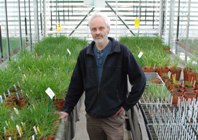Ryegrass genome

Dr Ian Armstead
14 May 2009
The Crop Genetics, Genomics and Breeding Division at the Institute of Biological, Environmental and Rural Sciences (IBERS), Aberystwyth University, has been awarded £1.6m to develop a physical map of the perennial ryegrass genome.
This research will be led by Drs Ian Armstead, Helen Ougham, Julie King, Lin Huang and Prof. Ian King and has been funded by the Biotechnology and Biological Sciences Research Council (BBSRC) with support from Germinal Holdings, Syngenta and ViaLactia Biosciences.
Ryegrass is the most commonly cultivated grass in the UK and forms a major component of both agricultural pastures and the grasses that are used in lawns, parks and sports turfs, and there is a long tradition of ryegrass breeding and research at Aberystwyth.
IBERS, the new research institute formed from the merger of the Aberystwyth University's Institutes of Biological Sciences and Rural Sciences, and the BBSRC-sponsored Institute of Grassland and Environmental Research (IGER), is continuing this tradition by combining the breeding and research practices established at IGER with new genomic approaches. This includes the development of a physical map of the perennial ryegrass genome.
The term genome refers to the complete set of DNA sequences in a particular species of plant, animal or other living organism, explains Dr Ian Armstead.
“Physical mapping is a strategy for cataloguing all the DNA sequences which make up a genome and then arranging them in order to build up a picture of the structure of that genome. This allows researchers to analyse the DNA sequence of specific genomic regions, for instance regions known to be important for drought tolerance or disease susceptibility, and so discover what genes are present within these regions.”
“In the medium term, it also paves the way for whole genome sequencing and hence the uncovering of the entire gene complement, as was done in the human genome project. It is this gene complement and the way in which the genes are controlled - turned on and off as necessary - which, ultimately, determine what any organism is and does. For ryegrass, this will contribute to the development of new grasses which can address issues of sustainability and performance under conditions of climate change.
“Additionally, it will lead to a greater understanding of the similarities and differences in makeup between the genomes of the related grass and cereal species, including wheat, oats and barley, upon which we all depend for food security. This work links with ongoing BBSRC-funded research at IBERS developing and aligning gene-based molecular markers across the range of important UK grasses and cereals”, he added.
Tradition
There is a long tradition of ryegrass breeding and research at Aberystwyth, dating back to the early 20th century and the establishment of the Welsh Plant Breeding Station (WPBS), and over the years this has led to the production of many new forage and turf grass varieties.
Now marketed under the ‘Aber' brand by IBERS' commercial partner Germinal Holdings, recent successes have included the ‘high sugar’ forage grasses AberDart and AberMagic, which have benefited both farmers and the environment by increasing the efficiency with which plant protein is converted to meat and milk.
Among the turf grasses, the ‘stay green’ variety AberNile has become well known under the guise of the ‘So Green’ lawn seed mixture and AberElf and AberImp have been widely used as sports turfs.
Research and breeding continues to produce new varieties of forage and amenity grasses which address not only immediate commercial concerns, but also longer term issues of sustainability. In this context, improving the endurance and performance of grasses under low water conditions and minimal fertiliser use are key targets.



